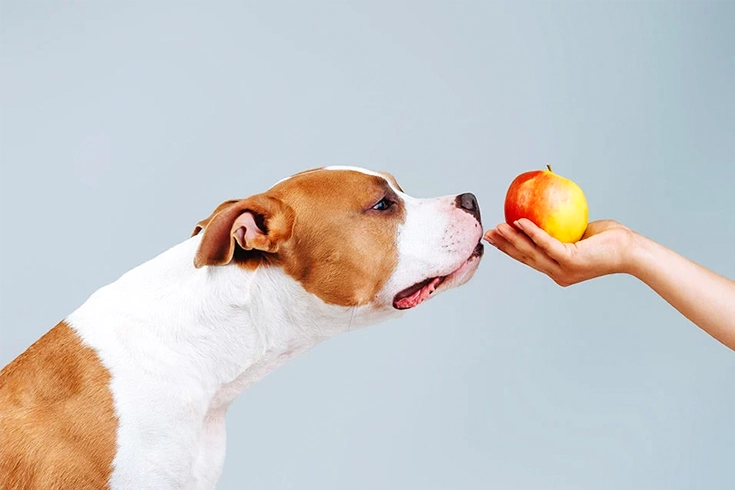
Can Dogs Eat Apples? Tips to Safely Feed Apple to Dogs
A well known saying, “An apple a day keeps the doctor away” that probably everyone has heard at least once in their lifetime. But the real question is about dogs; “can an apple a day keep the veterinarian away?”. Well, the answer can be a yes or no, and there could be certain limitations in dogs eating apples but apples are definitely a nutritious treat for dogs.
Although you can find Granny Smith, Gala, Fuji, Golden Delicious, Honeycrisp, Red Delicious, and many more apple types at any of the nearest grocery store which may be labelled as the safe and healthy food for your dog to eat. But it is mandatory to have a vet or nutritionist’s opinion on it that can help you in feeding apples to your pup without any hesitation. So, let’s proceed further to see Pets Life Expert’s Opinion!
Are Apples Good for Dogs?
Wondering is it safe for dogs to eat fruits? Yes! Apples are safe for dogs to eat! Apples are a great source of vitamins C and A, Nutrients, Potassium, and antioxidants. You can feed your dog fresh slices of apples including their skin. These apples are full of carbohydrates and fibers that help your dog’s maintain a healthy weight.
Also, these fibers assist fully in the digestion process and blood sugar regulation. However, dogs don’t need all these ingredients individually, rather, they need a complete and balanced diet for a healthy life. Although apple is a low calorie fruit it contains approximately 19 grams of sugar, which can be too much for a dog.
Are Apples Safe for Dog’s Teeth?
As we discussed earlier apples contain about 19 grams of sugar, dog owners might think it is bad for their dog’s teeth health due to sugar content. But the case is unlike, that because the water content in apples easily wash away the sugar content inside the mouth which is why it is comparatively safe for dog’s to eat apples.

Additionally, apple skin serves as a bonus by working as the toothbrush inside the mouth. So, apple is generally considered safe for dog’s teeth and won’t rot them at all. Apples skin scrapes tartar and plaque from your dog’s teeth, ensuring oral hygiene. Also, the malic acid in apples supports in freshening breath and keeping gum healthy.
How Many Apples Can Dogs Eat Per Day?
Your dogs might love eating apples but don’t let them eat apples too much. Serving apples in excess can lead to diarrhea and bellyache in your dogs. To satisfy your pup’s cravings, give a slice or two of an apple’s to your dog, and that too, occasionally.
If you are feeding apples to puppies, it is best to start with a small amount. Make sure to cut the apples into small cubes. Also, notice if they choke or have any problem in ingestion. Additionally, examine if they show any allergic reaction. If there’s a triggering reaction, immediately contact your veterinarian.

Regarding including apples in their diet, there are certain factors like dog’s age, breed, health, and size majorly matter. Here’s a general breakdown:
- Small dogs (Below 10 Pounds): 1-2 slices
- Medium dogs (11-50 Pounds): 2-4 slices
- Large dogs (Above 50 Pounds): 4-6 slices
Dog Size & Weight | Serving Amount |
Extra Small Dog (2-20 lbs.) | 1-2 Slices |
Small Dog (21-30 lbs.) | 2-3 Slices |
Medium Dog (31-50 lbs.) | 5-6 Slices |
Large Dog (51-90 lbs.) | Small Handful of Slices |
Extra Large Dog (91+ lbs.) | Large Handful of Slices |
How to Safely Prepare Apples for Dogs?
Apple can be fun and easy to feed to your dogs as a snack or treat. You don’t need to be fancy to make it ready for dogs to eat, but careful. Like, before feeding apples to dogs, you have to be sure of the quality, quantity, and hygiene for your dog’s safety. From washing apples and cutting stems/leaves to making slices and serving small, you need to follow the steps below to feed your dog apple.
Wash Your Apples
Begin by washing with cool water and scrubbing germs/bacteria because most apples are treated with pesticides to keep insects away and removing other harmful chemicals. These pesticides can be toxic to your dog’s health, so, wash carefully, and thoroughly.
Remove Seeds/Stems
To avoid choking and ensure easy eating, remove any stems and seeds. Apples seeds contain a small amount of poisonous cyanide. These seeds can harm your dog when served in large doses. It doesn’t make your dog sick though, but avoiding is best.
Cut Into Chunks/Slices
Depending on your dog’s breed and size, you can cut the apples into small eatable chunks. While larger breeds can have slices, but puppies can have intestinal blockage issue, so, it’s better to chop the slices to avoid any potential choking.
Remove the Apple Core
The tough apple core that can result into a dog choking and make intestinal pass-through difficult must be eliminated before serving apple slices to your dogs and puppies of any breed.
Peel the Apple
Although apple peel is not harmful it is not mandatory to remove it. However, doing so will reduce the amount of fiber intake and make it easier for a dog to digest an apple. Also, make sure to not overfeed the apple.
Creative Tips to Feed Apples to Dogs
Apple can be an interesting treat for dogs that can be served to dogs in multiple creative and fun ways that can be simple and easy to make. Your dog will definitely love apple based treats, so, here are different apple serving tips for dogs.
Serve as an Apple Snack
The easiest way to serve apples to your dogs is by making a snack. Simply cut the apples into small eatable pieces. The chopped pieces must be ¼-inch thick by 1 inch wide and serve them to your puppies as a treat.
Try Apple & Yogurt Mix
Another nutritious yet creamy treat can be made by mixing yogurt with diced apples. Use xylitol-free Greek yogurt to ensure a healthy and nutritious treat good for digestion. Then blend it thoroughly until it achieves the eatable consistency.
Go for Food Topper
One of the quickest hacks is to chop the apple pieces into sizeable chunks and place them over the routine dog food. You can mix them with the dog’s usual diet keeping adequate quantity while avoiding excess of anything.
Give after Making Ice cream
Making an apple ice cream for dogs is easy. All you have to do is freeze apple chunks in a bowl overnight. Next day mix the yogurt to create a delicious ice cream. Additionally, you can add any other dog safe frozen fruits to this treat before feeding a dog.
Prepare Apple Smoothie
To make an apple smoothie, select some other dog safe fruits, like bananas, strawberries, cranberries, and blueberries. You can use apples as a topper among all these fruits in a bowl. Grind/blend them well and serve it to your dog.
Treat with Apple Popsicles
To make an apple popsicle, you can take the yogurt and apple mixture from above into a popsicle tray and ice cubes. Let it freeze overnight and serve the next day to your puppies and dogs. This dog treat can be given to dogs as the popsicle stick.

Frozen Apple Treats
For hot days, frozen apples are a refreshing treat. By blending cut pieces into ice cubes with a little mix of water, you can let it freeze overnight. Get the frozen treat the next day to present to your dog and your feline will love it.
Apple Dog Biscuits
For making an apple biscuit for dogs, use oats, whole wheat flour, and applesauce, make a dough. Roll it out and cut in the shapes. Let it bake until it turns golden brown and crunchy to serve as the homemade dog biscuits.
Dehydrated Apples
Before you begin, make sure you have a dehydrator at home. For this, cut apple into pieces, spray lemon juice to avoid brown color, and align slices into the dehydrated tray. Set it to 135-150°F (57-66°C) for 6-10 hours. Get dehydrated apples with concentrated sugar amount and crispness.
Homemade Applesauce
Chop some apples, mix some water, and cook this mixture in a pot to boil. Mesh after it gets soft to the desired consistency. It’ll be the best applesauce, make sure to cool it down before feeding. However, you must not give applesauce in excess to your dog.
End Note
The query of “Can dogs eat apples?” is answered above in detail to address every dog parent’s concerns. While most parents wonder “Can my dog eat apples”, know that apples should include only 10% out of 100% of your dog’s diet. While it’s a source of hydration, fibers, carbohydrates, and nutrients, its sugar content can lead to obesity and diabetes. To know the safe amount, and easy apple recipes for dogs, this article will help every dog parent.
FAQs : Frequently Asked Questions
Can Dogs Eat Apple Peels?
Yes! Dogs can eat apple peels or apple skin. This peel is a great source of vitamins, minerals, & fibers which is good for dogs’ health.
Can Dogs Eat Apple Pie?
No! Dogs must not eat apple pie. It contains toxic ingredients like sugar, butter and fat, Nutmeg, and Cinnamon.
Can A Dog Eat Apple Seeds?
No! Dogs should not eat apple seeds. They contain amygdalin substance, which can be converted into cyanide (A poisonous substance) when ingested.
Is It Okay If Dogs Eat Apple Sauce?
Yes! Dogs can eat applesauce in a small amount. It comes with fibers and vitamins that help in digestion. However, avoid giving them to dogs with added sugar, cinnamon, or other spices.
Can Dogs Eat Apple Cores?
No! Dogs should not eat apple cores or seeds, as they contain cyanide. Also, Apple cores are hard and fibrous which can be a choking hazard.
Are Crab Apples Poisonous to Dogs?
No! Dogs should not eat crab apples. It also contains cyanide in its seeds, leaves, and stems. While crab apple flesh is safe for dogs, the seeds aren’t.
Can Dogs Eat Green Apples?
Yes! Dogs can eat green apples in small amounts. They are a safe and healthy treat for dogs because they contain antioxidants vitamins A and C, and fibers.
Can Dogs Have Apple Juice?
No! While raw apple in limited quantity is okay to give to your dog, apple juice with high sugar content and digestive upset trigger is generally not advised giving to dogs.
What Fruit Can Dogs Eat?
Dogs can eat apples, cucumbers, bananas, blueberries, cantaloupe, cranberries, strawberry, mangoes, peaches, oranges, and watermelon but in adequate amount.
What Vegetables Can Dogs Eat?
Dogs can eat raw bell peppers, broccoli, carrots, spinach, zucchini, cauliflower, lettuce, squash, pumpkin, and sweet potatoes.



